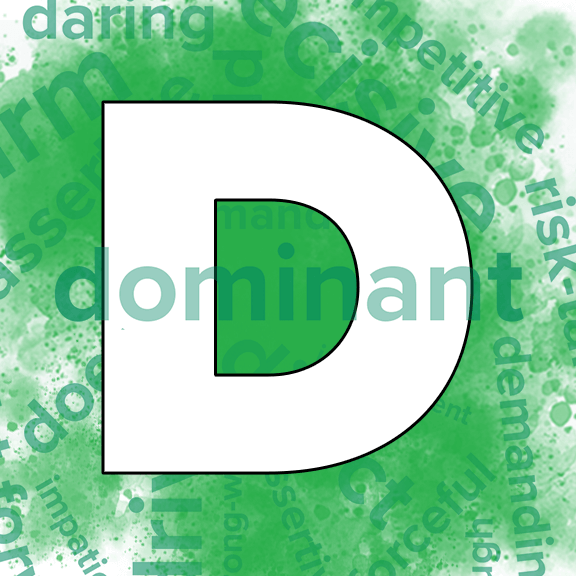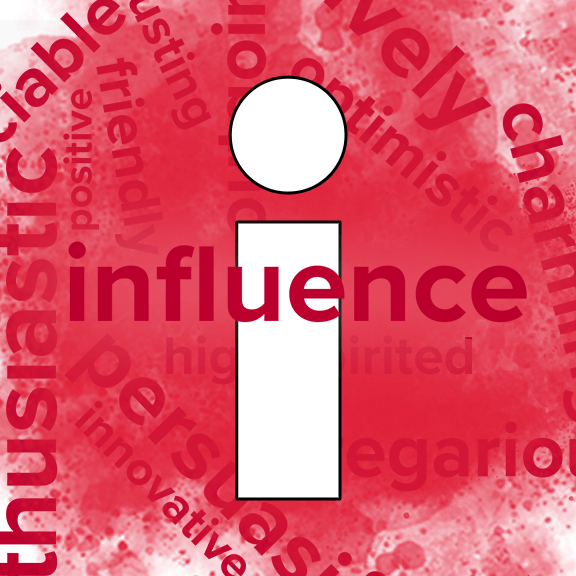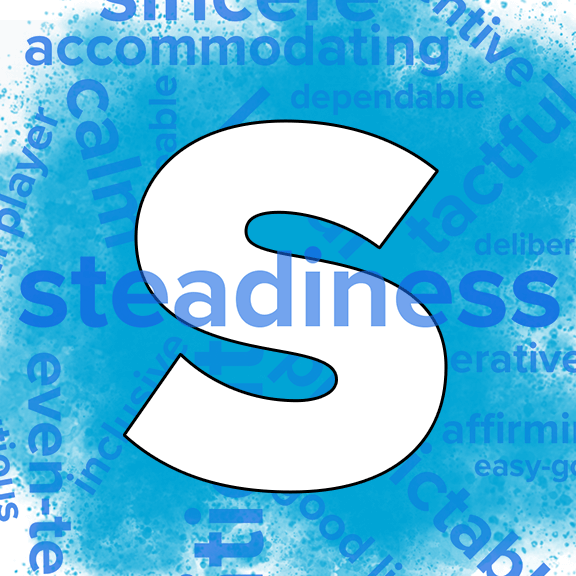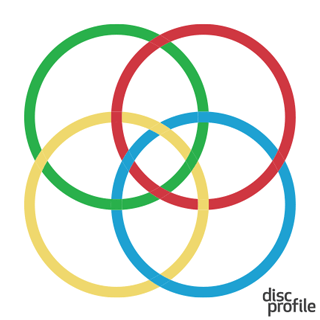
DiSC® styles
DiSC® is an acronym that stands for the four main behavioral styles outlined in the DiSC model of personalities. The lower-case i in DiSC identifies it as part of the original Everything DiSC® and DiSC® Classic family of products produced by Wiley.
D stands for Dominance, i stands for Influence, S stands for Steadiness, and C stands for Conscientiousness.

D = Dominance
A person primarily in this DiSC quadrant places emphasis on accomplishing results and “seeing the big picture.” They are confident, sometimes blunt, outspoken, and demanding.

i = influence
A person in this DiSC quadrant places emphasis on influencing or persuading others. They tend to be enthusiastic, optimistic, open, trusting, and energetic.

S = Steadiness
A person in this DiSC quadrant places emphasis on cooperation, sincerity, loyalty, and dependability. They tend to have calm, deliberate dispositions, and don’t like to be rushed.

C = Conscientiousness
A person in this DiSC quadrant places emphasis on quality and accuracy, expertise and competency. They enjoy their independence, demand the details, and often fear being wrong.

We are all combinations of each style
No DiSC style is "better" than any other, and we all use each of the four styles as we go about our daily lives. DiSC simply helps us find out which style we tend to gravitate toward most — our comfort zone. With that knowledge, we can understand our underlying tendencies and preferences and adapt our behaviors to interact with others more effectively.
DiSC style FAQs
First and foremost, DiSC profiles are about self-knowledge and communication. They are designed to help improve communication and cooperation in your workplace, boost the performance of teams, and improve the effectiveness of leaders and managers.
DiSC profiles provide a common language that people can use to help better understand themselves and their colleagues and then use that knowledge to adapt their behaviors and improve relationships.
Participants in DiSC profile assessments receive personalized insights that deepen their understanding of themselves and others, making workplace interactions more enjoyable and effective. The result can be a more engaged and collaborative workforce that can spark meaningful improvement in almost any organization.
To start the DiSC process, you simply answer a set of questions about your own personal behavior. For online assessments, a link to these questions is emailed to you with a personal access code; for the paper version of the DiSC Classic profile, they are given to you in a self-scored booklet. There are no right or wrong, good or bad responses to these questions – you are always considered the expert about what is important to you.
Your DiSC profile is then scored either electronically or by hand, and your personal profile report is produced.
The DiSC model describes four main styles: D, i, S, and C. D is for Dominance, i is for Influence, S is for Steadiness, and C is for Conscientiousness. Everyone is a mixture of each style, but most people tend to fall into one or two main DiSC style quadrants.
People whose DiSC assessment scores put them close to other styles can show aspects of multiple styles in their personalities. This expands the styles to a total of 12 distinct personality types: DC, D, Di, iD, i, iS, Si, S, SC, CS, C, and CD.
The use of a lowercase i in DiSC is one way to distinguish Everything DiSC® and DiSC® Classic from other assessments that are based on the DISC model. The DISC model couldn't be trademarked, but assessments and resulting reports could. The little i is part of the trademark held by John Wiley & Sons, Inc.
There are very few scoring differences based on demographics.
From the Everything DiSC Manual
Style preferences are equally distributed among the population:
“The standardization of the eight scales ensured that the assignment of DiSC styles was roughly equal across the twelve styles. The Everything DiSC assessment has been translated into other languages where local norm groups are used to establish the optimal items and norms for each scale.”
Gender
“These differences are generally small. The largest differences are seen on the iS scale, in which gender accounted for 3.7% of scale variance. Women tended to score higher on the i, iS, S, and SC scales, and men tended to score higher on the D, Di, C, and CD scales.”
Heritage
“These differences are generally small. The largest differences are seen on the CD scale, in which heritage accounted for 2.5% of scale variance.”
Education
“These differences are generally very small. The largest differences are seen on the Di scale, in which education accounted for .7% of scale variance.”
Ethnicity
“Practically speaking, knowing someone’s ethnic background will tell a practitioner almost nothing about that person’s DiSC style.”
The average person’s profile tends to stay fairly consistent over time. When someone takes the Everything DiSC assessment again, they generally do not answer the questions exactly the same way. The median change that we see is 12 degrees within the circle. So, someone’s dot is bound to move a little, even when the person is taking the same application.
If it's been two years or more since you last took the profile or you've been through a major life change, it’s a good idea to take the assessment again to ensure the most up-to-date information.
"What changes as you go through life are your roles and the issues that matter most to you. People may think their personality has changed as they age, but it is their habits that change, their vigor and health, their responsibilities and circumstances—not their basic personality," Daniel Goleman suggested in a New York Times article.
The distribution of successful people in each DiSC quadrant is actually pretty even. People in sales do tend to show up in the i quadrant as you may expect, for example, but there are plenty of successful salespeople in the other three.
DiSC is not designed for pre-employment screening. It doesn’t measure a particular skill, aptitude, or specific factor for a position. It’s a personality assessment designed to facilitate teamwork and communication.
For employment screening, we recommend using a proven, pre-hire assessment validated for that purpose such as PXT Select.
Yes. Please contact us if you have a need for profiles in other languages such as Chinese, Danish, Estonian, Finnish, French, German, Italian, Japanese, Norwegian, Spanish, Swedish, or Turkish.
The DISC Model of Behavior was first proposed by William Moulton Marston, a physiological psychologist with a Ph.D. from Harvard. His 1928 book, Emotions of Normal People, explains his theory of how normal human emotions lead to behavioral differences among groups of people and how a person’s behavior might change over time. His work focused on directly observable and measurable psychological phenomena.
There are no style “outliers” in the DiSC model published by Wiley. Everything DiSC assessments are normed so roughly 25 percent of the population falls into each quadrant. While there are four distinct styles, because a person can be a blend of styles, Everything DiSC actually encompasses 12 unique DiSC styles.

